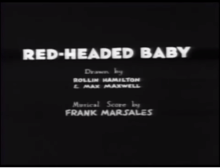Red-Headed Baby
| Red-Headed Baby | |
|---|---|
| Merrie Melodies series | |
 The title card of this short. | |
| Directed by | Rudolf Ising |
| Produced by |
Hugh Harman Rudolf Ising Leon Schlesinger |
| Music by | Frank Marsales |
| Animation by |
Rollin Hamilton Carman Maxwell (unc.) |
| Studio | Harman-Ising Productions |
| Distributed by |
Warner Bros. Pictures The Vitaphone Corporation |
| Release date(s) | December 26, 1931 |
| Color process | Black-and-white |
| Running time | 7 min. |
| Language | English |
| Preceded by | Hittin' the Trail for Hallelujah Land (1931) |
| Followed by | Pagan Moon (1932) |
Red-Headed Baby is a 1931 one-reel short animated film, part of the Merrie Melodies series.[1] It was released on December 26, 1931, and is directed by Rudolf Ising.[2][3] The short is notable for being the first Merrie Melodie to not feature recurring characters such as Foxy or Piggy, and also for being the first Warner Bros. cartoon to feature one-off characters (all shorts released prior to this one featured recurring characters such as Bosko, Foxy or Piggy).
Plot
Around Christmas Eve, a toymaker creates a red-haired doll, who, after he (the toymaker) departs, comes to life along with the other toys; she subsequently breaks into singing the titular song, in the process meeting a toy soldier (given the name 'Napoleon') who instantly falls for her.
However, a massive and thuggish spider also has fallen for the doll. He kidnaps her and beats the sawdust out of Napoleon. Napoleon fills his body up again and defeats the spider using a toy train. All the toys rejoice and the doll and Napoleon reunite as the titular song reprises, ending the cartoon.
References
- ↑ "Red-Headed Baby". IMDB. Retrieved 20 September 2015.
- ↑ "Red-Headed Baby (1931) - Merrie Melodies Theatrical Cartoon Series". The Big Cartoon Database. Retrieved 20 September 2015.
- ↑ "23. Red-Headed Baby (1931)". Likely Loonie, Mostly Merrie. Retrieved 20 September 2015.